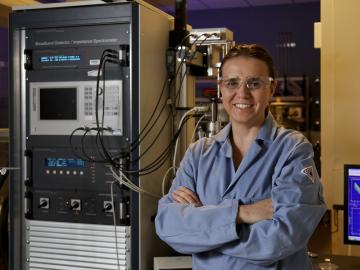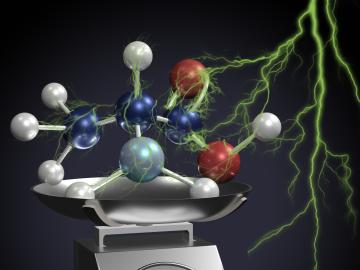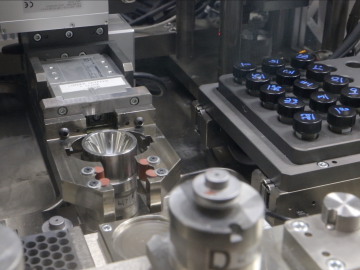
Filter News
Area of Research
- (-) Energy Science (33)
- (-) Materials (41)
- (-) Neutron Science (24)
- Advanced Manufacturing (3)
- Biological Systems (1)
- Biology and Environment (35)
- Computational Biology (2)
- Computational Engineering (2)
- Computer Science (5)
- Electricity and Smart Grid (1)
- Functional Materials for Energy (1)
- Fusion and Fission (4)
- Isotope Development and Production (1)
- Isotopes (10)
- Materials for Computing (7)
- National Security (36)
- Nuclear Science and Technology (8)
- Quantum information Science (4)
- Sensors and Controls (1)
- Supercomputing (45)
News Topics
- (-) Biomedical (23)
- (-) Cybersecurity (11)
- (-) Machine Learning (12)
- (-) Microscopy (29)
- (-) Security (8)
- (-) Space Exploration (8)
- 3-D Printing/Advanced Manufacturing (92)
- Advanced Reactors (9)
- Artificial Intelligence (16)
- Big Data (8)
- Bioenergy (34)
- Biology (19)
- Biotechnology (5)
- Buildings (38)
- Chemical Sciences (35)
- Clean Water (11)
- Composites (19)
- Computer Science (42)
- Coronavirus (23)
- Critical Materials (19)
- Energy Storage (88)
- Environment (67)
- Exascale Computing (3)
- Fossil Energy (3)
- Frontier (4)
- Fusion (8)
- Grid (40)
- High-Performance Computing (11)
- Hydropower (3)
- Irradiation (1)
- Isotopes (13)
- ITER (1)
- Materials (100)
- Materials Science (99)
- Mathematics (3)
- Mercury (3)
- Microelectronics (1)
- Molten Salt (3)
- Nanotechnology (45)
- National Security (7)
- Neutron Science (128)
- Nuclear Energy (23)
- Partnerships (16)
- Physics (30)
- Polymers (22)
- Quantum Computing (4)
- Quantum Science (16)
- Simulation (4)
- Statistics (1)
- Summit (9)
- Transportation (72)
Media Contacts

OAK RIDGE, Tenn., March 20, 2019—Direct observations of the structure and catalytic mechanism of a prototypical kinase enzyme—protein kinase A or PKA—will provide researchers and drug developers with significantly enhanced abilities to understand and treat fatal diseases and neurological disorders such as cancer, diabetes, and cystic fibrosis.


Vera Bocharova at the Department of Energy’s Oak Ridge National Laboratory investigates the structure and dynamics of soft materials.
![Coexpression_hi-res_image[1].jpg Coexpression_hi-res_image[1].jpg](/sites/default/files/styles/list_page_thumbnail/public/Coexpression_hi-res_image%5B1%5D_0.jpg?itok=ww635BCP)
While studying the genes in poplar trees that control callus formation, scientists at Oak Ridge National Laboratory have uncovered genetic networks at the root of tumor formation in several human cancers.

OAK RIDGE, Tenn., Jan. 31, 2019—A new electron microscopy technique that detects the subtle changes in the weight of proteins at the nanoscale—while keeping the sample intact—could open a new pathway for deeper, more comprehensive studies of the basic building blocks of life.

By automating the production of neptunium oxide-aluminum pellets, Oak Ridge National Laboratory scientists have eliminated a key bottleneck when producing plutonium-238 used by NASA to fuel deep space exploration.

Oak Ridge National Laboratory scientists studying fuel cells as a potential alternative to internal combustion engines used sophisticated electron microscopy to investigate the benefits of replacing high-cost platinum with a lower cost, carbon-nitrogen-manganese-based catalyst.

To learn more about interactions between drug molecules and micelles, Associate Professor Megan Robertson and graduate students Tyler Cooksey and Tzu-Han Li from the University of Houston (UH) are using neutrons at the Department of Energy’s (DOE’s) Oak Ridge National Laboratory (ORNL).
![2018-P07635 BL-6 user - Univ of Guelph-6004R_sm[2].jpg 2018-P07635 BL-6 user - Univ of Guelph-6004R_sm[2].jpg](/sites/default/files/styles/list_page_thumbnail/public/2018-P07635%20BL-6%20user%20-%20Univ%20of%20Guelph-6004R_sm%5B2%5D.jpg?itok=hUSyvkP0)
A team of scientists, led by University of Guelph professor John Dutcher, are using neutrons at ORNL’s Spallation Neutron Source to unlock the secrets of natural nanoparticles that could be used to improve medicines.

An Oak Ridge National Laboratory-led team used a scanning transmission electron microscope to selectively position single atoms below a crystal’s surface for the first time.


